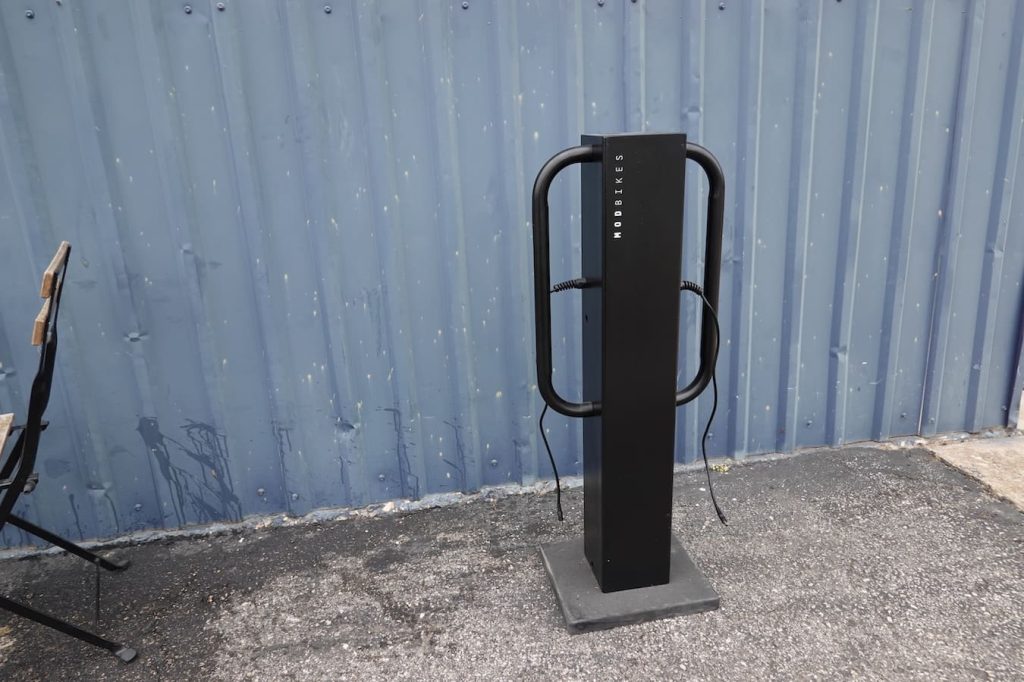There’s no doubt that the issue of safely charging e-bikes is a growing topic of concern in the US. And while the media frenzy around relatively rare e-bike fires is often overblown, it doesn’t rule out a real risk associated with lithium-ion batteries. Now, a new charging solution designed in the US could provide an answer to the problem.
I recently stumbled upon these two different models of e-bike charging stations when visiting Austin, Texas-based electric bike maker MOD Bikes.
The company just released several new models of e-bikes and updated their entire lineup with impressive features like torque sensors, color displays, dual battery support, and more. I had the opportunity to try several of them and I’ll have some in-depth reviews coming soon. But as impressive as the new e-bikes are, I found another surprise lurking in a corner of the company’s warehouse: a pair of in-house designed e-bike charging stations.
The two patent-pending charging stations offer a pair of divergent yet equally easy-to-install options that solve the problem of safe, secure charging.

The first style of charging station is intended for fleet use by MOD Bikes’ customers. For cases like law enforcement, where several bikes all using the same charger type are operated as a fleet, the primary charging station essentially works like a multi-pronged charging pedestal.
The chargers are designed to match MOD Bikes’ batteries, but they could be built to work with any specific type of e-bike battery, even with voltages or connection styles different from those used by MOD Bikes.
I learned that Tesla’s Gigafactory in Texas uses a fleet of e-bikes from MOD Bikes to get around the sprawling campus, including by the food staff for delivery catering all around the facility, and this type of charging station is intended to make it easy to charge such fleets of similar e-bikes.




But a second and perhaps more interesting charging station design offered much more versatility.
Designed for public use instead of by fleet operators, the second style of station includes a method to not only charge the bike, but also lock the charger and/or battery in the charging station.
It consists of a door with a latch that passes over the handle. Opening the hatch reveals a hollow space large enough to fit an e-bike charger and many different styles of e-bike batteries. There’s also a standard 120VAC electrical outlet in there, making this a BYOC (bring your own charger) type of affair.
To charge an e-bike, the rider’s own charger can be plugged into the outlet before closing the hatch door. As the latch slides over the handle, locking the bike to the pedestal will also lock the hatch closed, meaning no one can steal the charger. The charger’s wire can exit through a small gap, and the handle provides a secure location to lock the e-bike.

In cases where the rider wants to leave the battery but not the bike, such as overnight charging, the entire battery and charger can be placed in the unit and locked with a bike lock.
When I tested it, the pedestal was just large enough to barely fit the MOD Bikes charger and battery, though the company explained that they can build them to any size in order to accommodate larger batteries and chargers.
This would be an ideal solution for riders who don’t want to risk their bike sitting outside all night as an enticing target to bike thieves, but who also aren’t allowed to bring their battery indoors for charging, such as at many campuses and other areas now passing charging restrictions related to e-bikes.
Both of these solutions require a very small footprint, roughly 1 square foot of space for installation, yet provide a huge service for those who don’t have access to charging at either the ground level or in their homes and apartments.





Such public charging areas have long been the norm in China, where e-bikes are a much more common daily commuting vehicle than in the US.
These MOD Bikes designs adopt the same utility as Chinese models, but with increased security required in most American cities (in China, people usually just leave their chargers sitting on or next to their e-bikes and no one steals them).
MOD Bikes is currently looking for partners who want to run pilot programs to install the charging stations, either for fleet use or public charging. The company is able to produce them to fit various clients’ needs, with different charging voltages and connectors customized for various e-bikes.
Electrek’s Take
I think we are still in the early days of e-bike adoption in the US, and so charging is still being figured out in real-time. But in Asia and other countries with large e-bike adoption rates, public charging stations for e-bike batteries are already normal.
Just the other day I was walking through Dizengoff Center, a mall in Central Tel Aviv, when I spotted e-bike charging lockers that allow riders to deposit and charge their e-bike battery while they shop (seen below). It’s a different style, and also intended to be locked by a user-generated combination instead of using a bike lock, but it accomplishes the same goal of offering a safe charging location for the public.

I could see MOD Bikes’ solution being a simpler and more robust alternative for widescale parking, locking, and charging solutions as an all-in-one offering.
I wouldn’t be surprised if a decade from now, these charging and locking pedestals are commonplace in US cities.


